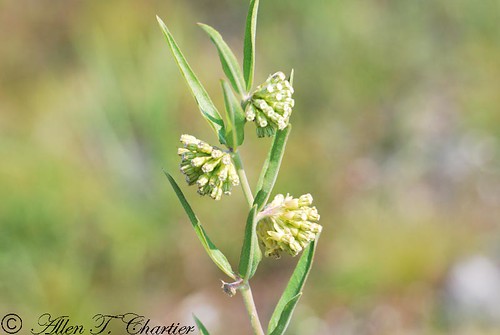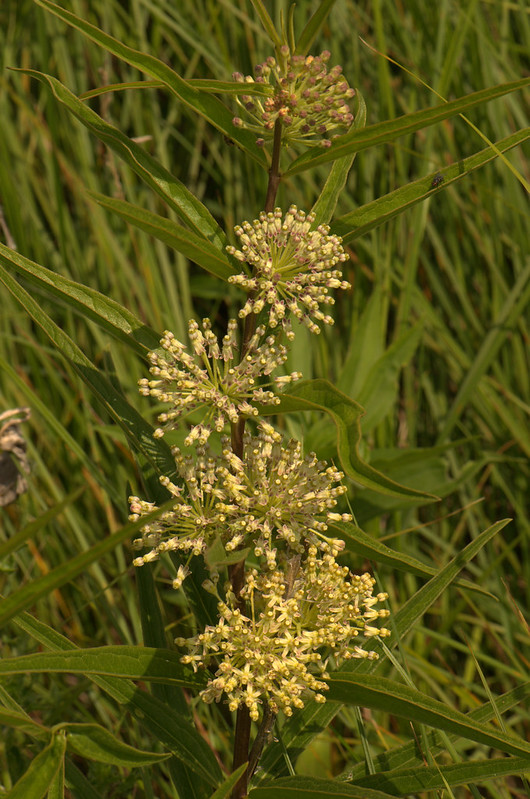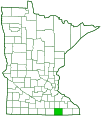prairie milkweed
(Asclepias hirtella)
Conservation • Description • Habitat • Ecology • Use • Distribution • Taxonomy
Conservation Status |
|
|||||||
| IUCN Red List | not listed |
|||||||
| NatureServe | NNR - Unranked S2 - Imperiled |
|||||||
| Minnesota | Threatened |
|||||||
Description |
||
Prairie milkweed is an erect, perennial herb that rises from a thick taproot. The leaves and stems contain a milky juice. The stems are erect, unbranched below the inflorescence. They are densely covered with short, soft hairs near the top, hairless or nearly hairless toward the bottom. The leaves are alternate, numerous, crowded, 4″ to 8″ long, ⅛″ to ½″ wide, lance-shaped to linear, with pointed tips. They are attached to the stem on short leaf stalks. The margins are untoothed, thickened, and rough to the touch. The inflorescence is 2 to 10 dense, umbrella-shaped clusters (umbels) rising from the upper leaf axils. The clusters are spherical, 2″ to 3″ in diameter, and are on a ½″ to 1½″ long stalk. They typically have 30 to 100 flowers. The structure of the typical milkweed flower is unique and instantly recognizable. There are 5 petals bent backward at the base and hanging downward. Subtending the petals are 5 much shorter, light green, lance-shaped sepals. There are 5 stamens. Formed from the filament of each stamen is a petal-like appendage. The appendage consists of a tubular hood surrounding an awl-shaped horn in the center of the hood. The stamens and the stigma are fused together into a crown-like structure (gynostegium). Each stigma has a long slit designed to catch the legs of a pollinating insect. A small, dark, sticky gland above this slit is attached to pollen sacs from adjacent anthers. These glands are designed to break off as an insect pulls its leg free of the slit, and remain attached to the insects leg. The flowers are pollinated by larger insects strong enough to lift off with the pollen sacs attached. Smaller insects are caught in a death trap or leave behind their detached legs. The flowers of this plant are shaped like the typical milkweed flower. They are ¼″ to ⅓″ tall, ⅓″ wide, and are attached on ¼″ to ½″ long thread-like stalks. The petals are greenish white and are tinged with purple near the tip. They bend backward at the base, hang downward, then curl upward near the tip. They are separated from the hoods by a distinct column. The hoods are greenish-white or white with a purplish tinge. They have no horns. There is little or no fragrance. The fruit is a narrow, spindle-shaped pod. It is about 4¾″ long and about ⅜″ wide. It is held erect or ascending on an erect stalk. It opens on one side exposing the seeds to spreading by the wind. The seeds have a tuft of hairs at the tip that are whitish and about 1⅛″ long. |
||
Height |
||
16″ to 40″ |
||
Flower Color |
||
Pale green to white with a purplish tinge |
||
Similar Species |
||
Green milkweed (Asclepias viridiflora) is a much shorter plant, 8″ to 20″ tall at maturity. The leaves are shorter and wider, lance-shaped to oblong, and mostly opposite. The lower surface of the leaf is downy and the margins are wavy. It usually has just 1 to 3 flower clusters. The flowers are not tinged with purple. The petals are attached directly to the hoods, not separated by a column. Oval-leaf milkweed (Asclepias ovalifolia) is a much shorter plant, 8″ to 24″ tall at maturity. The leaves are much shorter and wider. They are 2″ to 3″ long, lance-shaped to oblong, and opposite. It has a single loose flower cluster with 5 to 20 flowers at the end of the stem, and possibly 1 or 2 more clusters in the uppermost leaf axils. The flowers are greenish-white or greenish-purple. The petals are attached directly to the hoods, not separated by a column. The flowers have horns within their hoods. The fruits are shorter, 2⅛″ to 3⅛″ long. The tufts of hair attached to the seed tips are light brown. Whorled milkweed (Asclepias verticillata) is a much shorter plant, 8″ to 20″ tall at maturity. The leaves are extremely narrow, linear, and in whorls of 3 to 6. The flower heads have only 10 to 20 flowers. The flowers have horns within their hoods. |
||
Habitat |
||
Moist. Prairies. |
||
Ecology |
||
Flowering |
||
June to August |
||
Faunal Associations |
||
Milkweeds are the only plants that Monarchs lay their eggs on. The eggs are laid on the underside of healthy young leaves. |
||
Toxicity |
||
This and other milkweeds contain cardiac glycosides and may be poisonous to both humans and livestock. |
||
Pests and Diseases |
||
|
||
Use |
||
|
||
Distribution |
||||
|
Sources |
|||
| 4/22/2023 | ||||
Nativity |
||||
Native |
||||
Occurrence |
||||
Rare |
||||
Taxonomy |
|||
| Kingdom | Plantae (Plants) | ||
| Subkingdom | Pteridobiotina | ||
| Phylum | Tracheophyta (Vascular Plants) | ||
| Class | Magnoliopsida (Dicots) | ||
Order |
Gentianales (Gentians, Dogbanes, Madders, and Allies) | ||
Family |
Apocynaceae (dogbane) | ||
| Subfamily | Asclepiadoideae (milkweeds) | ||
| Tribe | Asclepiadeae | ||
| Subtribe | Asclepiadinae | ||
Genus |
Asclepias (milkweeds) | ||
Subordinate Taxa |
|||
|
|||
Synonyms |
|||
Acerates hirtella Asclepias longifolia var. hirtella Oligoron longifolium var. hirsutum |
|||
Common Names |
|||
green milkweed prairie milkweed tall green milkweed |
|||
Glossary
Axil
The upper angle where the leaf stalk meets the stem.
Gynostegium
A crown-like structure of plants of the genus Asclepias formed by the fusion of the anthers with the stigmas.
Linear
Long, straight, and narrow, with more or less parallel sides, like a blade of grass.
Umbel
A flat-topped or convex, umbrella-shaped cluster of flowers or buds arising from more or less a single point.
Visitor Photos |
|||||
Share your photo of this plant. |
|||||
| This button not working for you? Simply email us at info@MinnesotaSeasons.com. Attach one or more photos and, if you like, a caption. |
|||||
|
|||||
MinnesotaSeasons.com Photos |
|||||
|
|||||

Slideshows |
||
| Asclepias hirtella (Prairie Milkweed) Allen Chartier |
||

|
||
| A. hirtella Joshua Mayer |
||

|
||
About
Tall Green Milkweed |
||

Visitor Videos |
|||
Share your video of this plant. |
|||
| This button not working for you? Simply email us at info@MinnesotaSeasons.com. Attach a video, a YouTube link, or a cloud storage link. |
|||
Other Videos |
|||

Visitor Sightings |
|||||
Report a sighting of this plant. |
|||||
| This button not working for you? Simply email us at info@MinnesotaSeasons.com. Be sure to include a location. |
|||||
|
|||||
MinnesotaSeasons.com Sightings |
|||||
|
|||||

|
Created: Last Updated: © MinnesotaSeasons.com. All rights reserved. |
